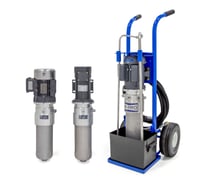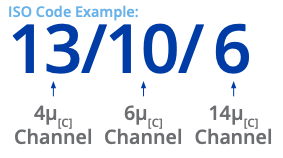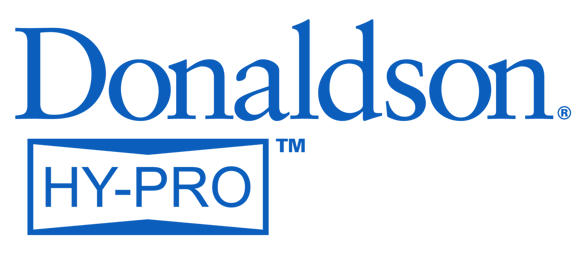5 min read
How Dirt Makes Dirt: The Hidden Cost of Particulate Contamination
By Jennie Bragg on Wed, Apr. 09, 2025
Topics: dirt ISO Fluid Cleanliness Codes cutdirtcutcosts cleanoil
1 min read
Hy-Pro's Product Spotlight: Compact Offline Filter (COF)
By Brad Bainbridge on Thu, Apr. 01, 2021
Hy-Pro's Compact Offline Filter
Our newest and smallest unit yet, the Compact Offline Filter is able to fit where no other filtration equipment can. Ideal for smaller systems or where a larger offline system wouldn't fit, this solution can be permanently installed or made portable for ease of use.
to fit where no other filtration equipment can. Ideal for smaller systems or where a larger offline system wouldn't fit, this solution can be permanently installed or made portable for ease of use.
Topics: hydraulic fluid contamination dirt Water Contamination hydraulic filters hydraulic and lubrication filter types Gearbox filtration new oil micro-dieseling fluid samples filtration oil analysis hydraulic pump filters hydraulic valve FSL liquid conditioning station duplex low-pressure oxidation Noria NSD hydraulic cellulose media compressor Reliable Plant filter comparison lube oil aluminum refinery conditioning turbine oil glass media
3 min read
Getting to Know Demulsibility
By Brad Bainbridge on Thu, Mar. 25, 2021
Demulsibility
What is Demulsibility?
Demulsibility is the ability of oil to separate from water. Oil and water naturally separate because like molecules attract each other. Oil sticks with oil, water sticks with water. Oil is "hydrophobic", or "afraid of water," which is a benefit when it comes to fluids like turbine oil.
Topics: varnish in hydraulic oil varnish in turbine oil contamination water in oil dirt Phosphate Ester diesel engine maintenance steel mills vacuum dehydration rolling mill lubricating oil filter housing sizing micro-dieseling thermal event ISO 4406 vacuum dehydrator fluid samples oil analysis metal analysis paper mill hydraulic pump samples COD duplex low-pressure gearbox contaminination hydraulic duplex high-pressure cellulose media filter elements filter comparison aluminum refinery lab
4 min read
Fluid Life Extension
By Brad Bainbridge on Thu, Mar. 11, 2021
Extending Fluid Life Saves Money and Helps the Environment
Our mission is to make our customers as efficient as possible, and we achieve that with the highest quality filtration products and total system cleanliness strategies to maximize uptime, productivity and prevent costly fluid contamination related failures. Been there. Done that. Going to do it again tomorrow. But that's not the only way we make our customers efficient. Extending the useful life of in-service fluids pays big dividends in reliability, saves money on premature fluid replacement costs, and reduces the environmental impact of industry by reducing the amount of fluids used and discarded. Enhancing reliability, saving money, and protecting the environment are not only good business, they're our responsibility. To help reduce oil usage, let's first understand why fluids are condemned and prematurely replaced.
Topics: varnish in hydraulic oil hydraulic fluid dirt vacuum dehydration filter housing sizing oil darkening mining fluid samples oil analysis filter performance paper mill fluid transfer filters filter cart gearbox LCS duplex high-pressure indianapolis filter elements lube oil turbine oil desiccant demulsibility
2 min read
Understanding ISO Codes
By Brad Bainbridge on Thu, Feb. 25, 2021
ISO Cleanliness Codes Explained
The ISO Cleanliness Code (per ISO4406-1999) is used to quantify particulate contamination levels per milliliter of fluid at 3 sizes - 4µ, 6µ, and 14µ. It is expressed in 3 numbers (example 19/17/14) where each number represents a contaminant level code for the correlating particle size. The code includes all particles of the specified size and larger. It is important to note that each time a code increases, the quantity range of particles is doubling. Inversely, as a code decreases by one the contaminant level is cut in half.
It is important to note that each time a code increases, the quantity range of particles is doubling. Inversely, as a code decreases by one the contaminant level is cut in half.




.png?width=600&height=230&name=Copy%20of%20Blog%20Podcast%20(4).png)
